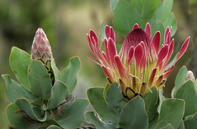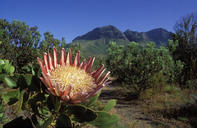World's Richest Flora
The Hottentots Holland Mountains, which separates the Peninsula from the immediate hinterland, contains perhaps the world's richest flora, with a profusion of flowering plants that for centuries has awed botanists and delighted mountaineers.

There are 21 species of subtly-shaded Gladiolus found in these mountains, many types of orchids such as the Red disa (Disa uniflora), Blue disa (Herschelia graminifolia) and the 'moederkappie' (Disperis capensis).
Grandest Fynbos Flower

You’ll find the grandest fynbos flower in the Hottentots Holland Mountains: the King protea (Protea cynaroides). Other flowers include the velvety pink Protea compacta, the Sugarbush (P. neriifolia) and milk-white (P. lacticolor), squadrons of Leucadendrons (Cone Bushes) and Leucospermums (Pincushions), Lobelias, Watsonias. 26 species of Sorrel (Oxalis) that are harbingers of winter, over 200 varieties of Erica's of every shape and colour imaginable, gorgeous irises, such as Moraeas, and fields of scarlet, mauve or purple Watsonias.
The showy Mimetes genus also occurs here, such as M. argenteus whose soft red and yellow flowers flare out between tight clusters of silvery leaves. Carolus Linnaeus, the indefatigable 18th-century scientist who devised the modern binomial system of taxonomy, called the Cape 'that paradise on earth'. It was he who named the genus Protea after the Greek god Proteus who could appear in any number of guises.
 The Hottentots Holland Nature Reserve is home to various plants and animals, including 1300 fynbos species, grey rhebok, klipspringer, duike...
The Hottentots Holland Nature Reserve is home to various plants and animals, including 1300 fynbos species, grey rhebok, klipspringer, duike...